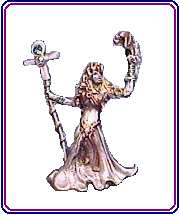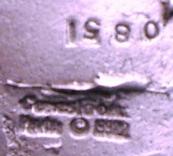



Though we are not experts or authorities on pewter figurines, we have learned many things over the years. We hope you find this information helpful in your search for pewter figurines both on the Internet and in retail stores.
"SIGNED" PEWTER FIGURINES:
Some of the pewter figurines shown on our site bear a stamp of the artist's signature who originally created the figurine. While some people prefer signed pieces, this alone does not increase its value. We simply point out a signature because there are people who collect figurines designed by one well-known pewter artist over others. It's a matter of personal taste and what you like.

STAMPED, NUMBERED, DATED ... WHAT'S IT ALL MEAN?
Most pewter figurines created today by the major manufacturers are stamped with the manufacturer's name as well as the item number and possibly the year it was designed. Like a signature, this does not necessarily add to a pewter figurine's value. Some people may list pewter figurines on a website or on an electronic auction as "stamped and numbered", "signed and numbered", or "stamped and dated". They would like people to believe that this makes the pewter figurine somehow more "special" and valuable. This is usually not the case. The exception to this would be a pewter figurine that is part of a limited edition collection. In such cases, a figurine will indicate which number it is (i.e., 761/2500 which would translate to figurine number 761 out of 2,500 pieces). Some limited edition pieces may also come with a certificate of authenticity. Our suggestion would be to contact the seller of the piece and ask questions. Unless there are two numbers suggesting the figurine is a limited edition piece, the number appearing on a figurine is most likely nothing more than the item number given to it by the manufacturer.
Below you can see an example that shows the manufacturer's name, a date, and an item number. This is what some people refer to as "stamped and numbered" or "stamped and dated".

This marking showing a manufacturer's name,
an item number, and the year it was designed
does not add to the value or desirability of a
pewter figurine.
There are times when a manufacturer may discontinue (or "retire") a pewter figurine. This means that the manufacturer will discontinue production of the figurine and it has limited availability. Many of the manufacturers will destroy a mold once it's been "retired". If it's a pewter figurine you like, by all means add it to your collection. The pewter figurine may or may not go up in value. The main thing to keep in mind when shopping for pewter is to get a figurine because you like it and not because you expect it to be worth more in the years to come. Keep in mind that while it doesn't happen often, a pewter manufacturer may retire a figurine only to reissue it at a later time with some minor or major differences made to the original figurine.

PEWTER CARE:
We are often asked how to care for pewter figurines. Unlike silver, modern lead-free pewter made in the United States does not tarnish because it no longer contains lead. Pewter must contain a minimum of 90% tin. The rest is composed of antimony and copper. Your pewter figurines may need an occasional dusting with a soft cloth but not much more to keep them looking beautiful for years to come. Never use any type of abrasive cloth, cleanser or cleaning sprays on your figurines as this may cause permanent damage. If you feel you need to clean your pewter figurines, use only mild soap and warm water or a cleaner specifically meant for pewter and related metals. As with dusting, use a soft cloth. Be sure to dry your figures thoroughly.

Use of any type of abrasive cleanser or spray may cause permanent damage to your figurines!
Modern-day pewter figurines come in a variety of finishes from buffed satin to a sparkling white sterling silver finish. There are some pewter figurines that appear a bit darker or "older" than others. This does not necessarily mean the figurine contains lead or is an older figurine. The figurine was most likely put into an oxidizing solution to give it an "older" appearance. We make our own oxidizing solution to "age" or darken some of our pewter figurines. Some figurines are also diamond-cut along the edges. This can be a dramatic effect.
Compared to platinum, gold, and silver, pewter is a relatively soft metal. Because of this, care should be taken to protect your pewter figures from falling. Pewter figurines with small and/or delicate parts can often bend or break all together and are difficult or impossible to repair depending on the damage done.

To return to the previous page, please use the back arrow on your browser.





























